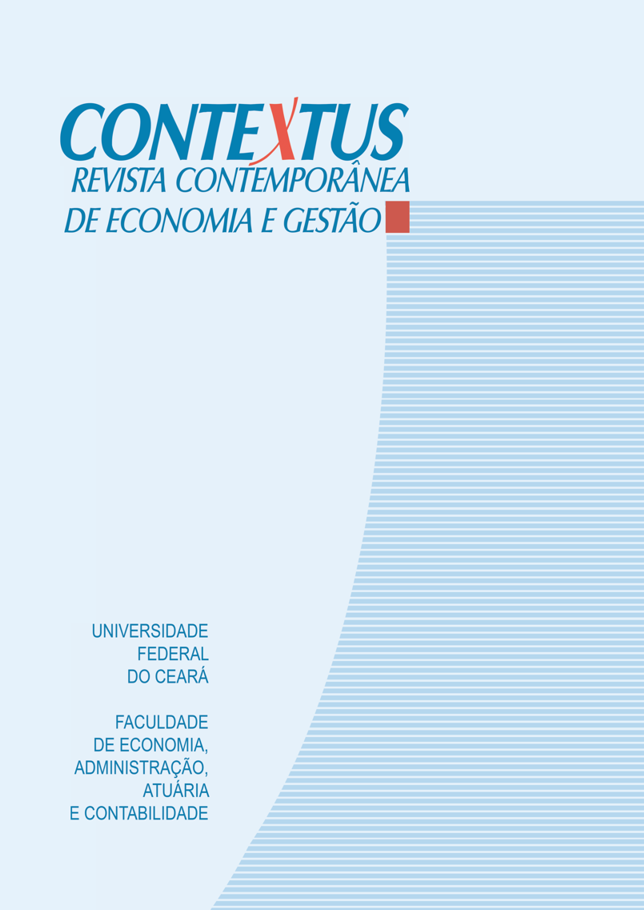Antecedents of the adoption of Social Media Marketing by micro and small enterprises
DOI:
https://doi.org/10.19094/contextus.2023.88631Keywords:
antecedents, adoption of Social Media Marketing, micro and small enterprises, structural equation modeling, entrepreneursAbstract
The adoption of Social Media Marketing (SMM) is increasingly present in the daily life of companies. However, little is known about this phenomenon in the context of micro and small businesses (MSEs). The research aimed to analyze the SMM adoption process by MSEs, based on a study with 338 entrepreneurs linked to the Brazilian Micro and Small Business Support System (Sebrae), using Structural Equation Modeling. It was found that technical knowledge, cost reduction, and pressure from customers and competitors generate benefits perceived by entrepreneurs concerning the use of the tool, leading to a higher level of use. The work contributes to the step in which it brings evidence that helps to understand the determinants of adopting SMM in the context of MSEs.
Downloads
References
Alalwan, A. A., Rana, N. P., Dwivedi, Y. K., & Algharabat, R. (2017). Social media in marketing: A review and analysis of the existing literature. Telematics and Informatics, 34(7), 1177-1190. https://doi.org/10.1016/j.tele.2017.05.008
Alford, P., & Page, S. J. (2015). Marketing technology for adoption by small business. Service Industries Journal, 35, 655-669. https://doi.org/10.1080/02642069.2015.1062884
Almeida, M. I. S., Coelho, R. Li. F., Camargo, A., Filho, Gomes, A. C., & Porto, R. B. (2017). Marketing and social media long run performance implications : A time series experiment on small retailing. October.
Alsaleh, D. A., Elliott, M. T., Fu, F. Q., & Thakur, R. (2019). Cross-cultural differences in the adoption of social media. Journal of Research in Interactive Marketing, 13(1), 119-140. https://doi.org/10.1108/JRIM-10-2017-0092
Anderson, J. C., & Gerbing, D. W., (1988). Structural equation modeling in practice: a review and recommended two-step approach. Psychol. Bull, 103(3), 411-423.
Arantes, R. D. C., Pereira, M. M. O., Castro, C. C. D., Mineiro, A. A. D. C., & Oliveira, J. A. (2021). A transformação digital e o conhecimento organizacional: uma revisão sistemática da literatura. Revista Contemporânea de Economia e Gestão, 19, 316-329. https://doi.org/10.19094/contextus.2021.71301
Bagozzi, R.P., & Yi, Y. (1988). On the evaluation of structural equation models. Journal of the Academy of Marketing Science, 16, 74-94.
Byrne, B. M. (2013). Structural equation modeling with Mplus: Basic concepts, applications, and programming. New York: Routledge.
Chatterjee, S., & Kumar Kar, A. (2020). Why do small and medium enterprises use social media marketing and what is the impact: Empirical insights from India. International Journal of Information Management, 53, 102-103. https://doi.org/10.1016/j.ijinfomgt.2020.102103
Choi, Y., & Thoeni, A. (2016). Social media: is this the new organizational stepchild? European Business Review, 28(1), 21-38. https://doi.org/10.1108/EBR-05-2015-0048
Cohen, J. (1988). Statistical power analysis for the behavioral sciences. (2th ed.). Hillsdale, NJ: Erlbaum.
Cronbach, L. J. (1951). Coefficient alpha and the internal structure of tests. Psychometrika, 16(3), 297-334.
Dahnil, M. I., Marzuki, K. M., Langgat, J., & Fabeil, N. F. (2014). Factors Influencing SMEs Adoption of Social Media Marketing. Procedia - Social and Behavioral Sciences, 148, 119-126. https://doi.org/10.1016/j.sbspro.2014.07.025
Eid, R., Abdelmoety, Z., & Agag, G. (2020). Antecedents and Consequences of Social Media Marketing Use: An Empirical Study of the UK Exporting B2B SMEs. Journal of Business and Industrial Marketing, 35(2), 284-305.
Eze, S. C., Chinedu-Eze, V. C. A., & Awa, H. O. (2021). Key Success Factors (KSFs) Underlying the Adoption of Social Media Marketing Technology. SAGE Open, 11(2). https://doi.org/10.1177/21582440211006695
Fornell, C., & Larcker, D.F. (1981). Evaluating structural equation models with unobservable variables and measurement error. Journal of Marketing Research, 18(1), 39-50.
Gonçalves, A., Nascimento, L., Bouzada, M., & Pitassi, C. (2016). Fatores que impactam na adoção e implementação do sped na avaliação dos gestores das empresas brasileiras. Journal of Information Systems and Technology Management, 13(2), 193–218. https://doi.org/10.4301/s1807-17752016000200003
Gutierrez-Leefmans, C., Nava-Rogel, R. M., & Trujillo-León, M. A. (2019). How Are dynamic capabilities and digital marketing related? A reflection from literature. Revista Eletrônica de Estratégia & Negócios, 11(3), 265-283. https://doi.org/10.19177/reen.v11e32018265-283
Hair, J. F., Black, W.C., Babin, B. J., Anderson, R. E., & Tatham, R. L. (2018). Multivariate Data Analysis (8th ed.). London: Pearson.
Kaplan, A. M., & Haenlein, M. (2010). Users of the world, unite! The challenges and opportunities of social media. Business Horizons, 53(1), 59-68. https://doi. org/10.1016/j.bushor.2009.09.003
Kline, R. B. (2011). Convergence of structural equation modeling and multilevel modeling. In M. Williams (Ed.), Handbook of Methodological Innovation. California: Sage, Thousand Oaks.
Kumar, A., Syed, A. A., & Pandey, A. (2021). Adoption of online resources to improve the marketing performance of SMES. Asia Pacific Journal of Health Management, 16(3), 137-144.
Kumar, A., & Möller, K. (2018). Extending the boundaries of corporate branding: An exploratory study of the influence of brand familiarity in recruitment practices through social media by B2B firms. Corporate Reputation Review, 21(3), 101-114. https://doi.org/10.1057/s41299-018-0046-7
Li, F., Larimo, J., & Leonidou, L. C. (2023). Social media in marketing research: Theoretical bases, methodological aspects, and thematic focus. Psychology and Marketing, 40(1), 124-145. https://doi.org/10.1002/mar.21746
Malhotra, N. K. (2019). Pesquisa de marketing: uma orientação aplicada. (7 ed.). Porto Alegre: Bookman.
Matikiti, R., Mpinganjira, M., & Roberts-Lombard, M. (2018). Application of the Technology Acceptance Model and the Technology–Organisation–Environment Model to examine social media marketing use in the South African tourism industry. SA Journal of Information Management, 20(1), 1-12. https://doi.org/10.4102/sajim.v20i1.790
Melo, C. O., Luft, M. C. M. S., & Rocha, R. O. (2021). Influencing elements of technological adoption: Case study about management in an educational institution. Contextus – Revista Contemporânea de Economia e Gestão, 19, 124-145. https://doi.org/10.19094/contextus.2021.61445
Pandey, N., Nayal, P., & Rathore, A. S. (2020). Digital marketing for B2B organizations: structured literature review and future research directions. Journal of Business and Industrial Marketing, 35(7), 1191-1204. https://doi.org/10.1108/JBIM-06-2019-0283
Patma, T. S., Wardana, L. W., Wibowo, A., & Narmaditya, B. S. (2020). The Shifting of Business Activities during the COVID-19 Pandemic: Does Social Media Marketing Matter? Journal of Asian Finance, Economics and Business, 7(12), 283-292. https://doi.org/10.13106/JAFEB.2020.VOL7.NO12.283
Picoto, W. N., Crespo, N. F., & Carvalho, F. K. (2021). The Influence of the Technology-Organization-Environment Framework and Strategic Orientation on the Use of Cloud Computing, Enterprise Mobility and Performance. Revista Brasileira de Gestao de Negócios, 23(2), 278-300. https://doi.org/10.7819/rbgn.v23i2.4105
Porter, C. E., & Donthu, N. (2006). Using the technology acceptance model to explain how attitudes determine Internet usage: The role of perceived access barriers and demographics. Journal of Business Research, 59, 999-1007. https://doi. org/10.1016/j.jbusres.2006.06.003
Praveena, K., & Thomas, S. (2014). Intenção de continuar a usar o Facebook: um estudo de prazer percebido e TAM. Bonfring International Journal of Industrial Engineering and Management Science , 4(1), 24-29.
Ratnasingam, J., Ioras, F., Liat, L., Ayenkaren, J., Yi, L., & Labtib, H. A. (2021). Digital technology application among Malaysian value-added wood products manufacturers. BioResources, 16(2), 2876-2890.
Salwani, M. I., Marthandan, G., Norzaidi, M. D., & Chong, S. C. (2009). E-commerce usage and business performance in the Malaysian tourism sector: Empirical analysis. Information Management & Computer Security, 17(2), 166-185. https:// doi.org/10.1108/09685220910964027
Santos, S. S. S., Begnini, S., & Carvalho, C. E. (2020). O efeito do uso das mídias sociais e das capacidades dinâmicas no desempenho mercadológico de micro, pequenas e médias empresas. Revista Brasileira de Marketing, 19(1), 174-196. https://doi.org/10.5585/remark.v19i1.17346
Sarin, P., Kar, A. K., & Ilavarasan, V. P. (2021). Exploring engagement among mobile app developers – Insights from mining big data in user generated content. Journal of Advances in Management Research, 18(4), 585-608.
Serviço Brasileiro de Apoio às Micro e Pequenas Empresas. (2020). Pequenos negócios em números. https://www.sebrae.com.br/sites/PortalSebrae/ufs/sp/sebraeaz/pequenos-negocios-em-numeros,12e8794363447510VgnVCM1000004c00210aRCRD
Shen, G. C. (2015). Como a qualidade de vida afeta a intenção de usar sites de redes sociais: Papel moderador da auto-revelação. Journal of Electronic Commerce Research, 16(4), 276-289.
Silva, S. C. E., Duarte, P. A. O., & Almeida, S. R. (2020). How companies evaluate the ROI of social media marketing programmes: insights from B2B and B2C. Journal of Business and Industrial Marketing, 35(12), 2097-2110. https://doi.org/10.1108/JBIM-06-2019-0291
Souza, C. A., Siqueira, É. S., & Reinhard, N. (2017). Digital divide of small and medium-sized enterprises: An analysis of influencing factors using the toe theory. Revista de Administração Mackenzie, 18(2), 15-48. https://doi.org/10.1590/1678-69712017/administracao.v18n2p15-48
Tarsakoo, P., & Charoensukmongkol, P. (2019). Dimensions of social media marketing capabilities and their contribution to business performance of firms in Thailand. Journal of Asia Business Studies, 14(4), 441-461. https://doi.org/10.1108/JABS-07-2018-0204
Tornatzky, L. G., & Fleischer, M. (1990). Processo de inovação tecnológica. Massachusetts: Lexington Books.
Tukey, J. W. (1977). Some thoughts on clinical trials, especially problems of multiplicity. Science, 198(4318), 679-684.
Wanyoike, D. M., Mukulu, E., & Waititu, A. G. (2012). ICT attributes as determinants of e-commerce adoption by formal small enterprises in urban Kenya. International Journal of Business and Social Science, 3(23), 65-74.
Yao, B., Shanoyan, A., Peterson, H. H., Boyer, C., & Baker, L. (2019). The use of new-media marketing in the green industry: Analysis of social media use and impact on sales. Agribusiness, 35(2), 281-297. https://doi.org/10.1002/agr.21581
Yilmaz, H. (2018). Measuring egocentric, adaptive and pathological forms of selfishness: scale adaptation study. J. Acad. Soc. Sci., 6(74), 45-57.
Zhu, K., & Kraemer, K. L. (2005). Variações pós-adoção no uso e valor de e negócios por organizações: Evidências cross-country da indústria de varejo. Pesquisa de Sistemas de Informação, 16(1), 61-84. https://doi.org/10.1287/isre.1050
Published
How to Cite
Issue
Section
License
Copyright (c) 2023 Journal: only for the 1st publication

This work is licensed under a Creative Commons Attribution-NonCommercial 4.0 International License.
The authors, while doing the submission, accept the notice below:
We authors hold the copyright related to our paper and transfer Contextus journal the right for the first publication with a Creative Commons’ international license of the modality Attribution – Non-commercial 4.0, which in turn allows the paper to be shared providing that both the authorship and the journal’s right for initial release are acknowledged.
Furthermore, we are aware of our permission to take part in additional contracts independently for non-exclusive distribution of the version of our work published in this journal (e.g. publishing it in an institutional repository or as a book chapter), while acknowledging both the authorship and the journal’s initial publication.
We also certify that the paper is original and up to this date has not been released in any other journal, Brazilian or of another nationality, either in Portuguese or another language, as well as it has not been sent for simultaneous publication in other journals.
Last, we not only know that plagiarism is not tolerated by Contextus but also certify the paper presents the sources of passages from cited works, including those authored by ourselves.










1.jpg)



1.jpg)

1.jpg)



.jpg)



1.jpg)

1.jpg)


1.jpg)

1.jpg)
1.jpg)
2.png)




2.jpg)
1.jpg)




1.jpg)


1.jpg)
1.jpg)
